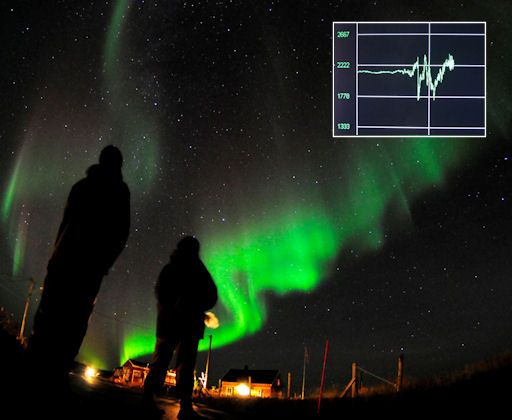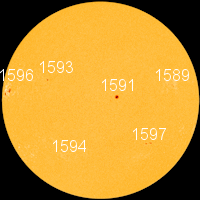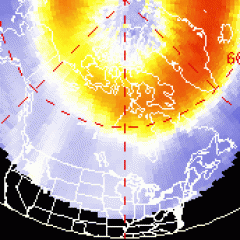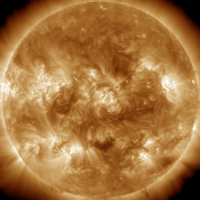ORIONID METEOR SHOWER: Next weekend, Earth will pass through a stream of debris from Halley's Comet, source of the annual Orionid meteor shower. Forecasters expect ~25 meteors per hour when the shower peaks on Oct. 21st. [video] [full story] [NASA Chat]
METEOR MAKES LANDFALL: A small asteroid that exploded over the San Francisco Bay Area on Oct. 17th, shaking houses with its sonic boom, might have scattered pieces of itself on the ground. That's the conclusion of Peter Jenniskens of the NASA Ames Research Center. He triangulated data from a pair of meteor surveillance cameras to determine the fireball's trajectory, denoted by the black arrow in the map below:
"The asteroid entered at a [relatively slow] speed of 14 km/s. There's a good chance that a fairly large fraction of this rock survived and fell somewhere around the North Bay," says Jenniskens. "Much more accurate results will follow from a comprehensive study of the video records. Now, we hope that someone recovers a meteorite on the ground."
In the map, red dots represent the surveillance cameras Jenniskens used to calculate the trajectory. The black arrow traces the asteroid's path; 85 km and 39 km are the altitudes of the asteroid at the two ends of the arrow. Jenniskens adds that "39 km is not the end point, but the final bit captured by the San Mateo video camera." The disintegrating asteroid continued beyond the tip of the arrow for a possible landfall somewhere north of San Francisco. Stay tuned for updates on the meteorite hunt.
GROUND AND SKY CURRENTS: For the second day in a row, a ~500 km/s solar wind speed is buffeting Earth's magnetic field, igniting auroras around the Arctic Circle. In Lofoten Norway on Oct. 17-18, the reverberating magnetic field induced electrical currents in the ground. "When we saw the currents on our monitors, we rushed outside to see the auroras," says Jan Koeman, who took this picture:
"It was a beautiful display," says Koeman. NOAA forecasters estimate a 10% to 15% chance of geomagnetic activity around the Arctic Circle tonight in response to the waning solar wind stream. However, based on Koeman's experience--"This was our sixth night in a row with clear skies and auroras," he says--the odds of a light show seem even higher. Arctic sky watchers should remain alert for auroras on Oct. 19th, especially during the hours around local midnight. Aurora alerts: text, voice.

![]()
Solar wind
speed: 435.6 km/sec
density: 0.6 protons/cm3
explanation | more data
Updated: Today at 1435 UT
![]()
X-ray Solar Flares
6-hr max: B7 1358 UT Oct19
24-hr: C1 0519 UT Oct19
explanation | more data
Updated: Today at: 1359 UT
![]()
![]()
![]()
Daily Sun: 19 Oct 12
![]()
![]()
New sunspot 1596 is large and might pose a threat for M-class solar flares. More about this active region will be known in the days ahead as it turns to face Earth. Credit: SDO/HMI
![]()
![]()
![]()
Sunspot number: 112
What is the sunspot number?
Updated 19 Oct 2012
Spotless Days
Current Stretch: 0 days
2012 total: 0 days (0%)
2011 total: 2 days (<1%)
2010 total: 51 days (14%)
2009 total: 260 days (71%)
Since 2004: 821 days
Typical Solar Min: 486 days
Update 19 Oct 2012
The Radio Sun
10.7 cm flux: 138 sfu
explanation | more data
Updated 19 Oct 2012
![]()
![]()
![]()
Current Auroral Oval:
![]()
Switch to: Europe, USA, New Zealand, Antarctica
Credit: NOAA/POES
![]()
![]()
![]()
Planetary K-index
Now: Kp= 1 quiet
24-hr max: Kp= 2 quiet
explanation | more data
![]()
Interplanetary Mag. Field
Btotal: 2.6 nT
Bz: 2.3 nT north
explanation | more data
Updated: Today at 1437 UT
![]()
![]()
![]()
Coronal Holes: 19 Oct 12
![]()
![]()
There are no large coronal holes on the Earthside of the sun. Credit: SDO/AIA.






